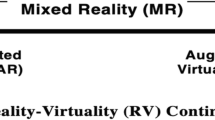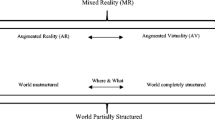Abstract
This study aims to investigate the effect of mixed reality applications on students' motivation to learn science. The study further aims to identify students' attitudes toward augmented reality applications and also intends to explore the students' views on mixed reality applications. A total of 42 primary school students participated in the study for a duration of 8 weeks. The results of the study indicate that mixed reality applications are effective in students' motivation for collaborative work in science teaching. In this context, it can be stated that mixed reality applications can make a significant contribution to the students' potential of collaboration with their peers. In the research, it was concluded that students were willing to use the augmented reality applications in science teaching and their anxiety levels decreased. The results obtained reveal that students are pleased to use augmented reality applications in science teaching. Qualitative data obtained from student views also support the quantitative results. The majority of the students stated that mixed reality applications should be employed in all courses and expressed that they are excited about the use of these applications and feel motivated for science teaching.


Similar content being viewed by others
Explore related subjects
Discover the latest articles, news and stories from top researchers in related subjects.References
Alhumaidan, H., Lo, K. P. Y., & Selby, A. (2018). ‘Co-designing with children a collaborative augmented reality book based on a primary school textbook. International Journal of Child-Computer Interaction, 15, 24–36.
Atasoy, B., Gün, E. T., & Karoğlu, A. K. (2017). Elementary school students' attitudes and motivations towards augmented reality practices. Journal of Kırşehir Education Faculty, 18(2), 435–448.
Banqueri, E. (2016). Secrets of the earth (Augmented Reality): Our planet. London: Design Media Publishing (UK) Limited.
Bin, S., Masood, S., and Jung, Y. (2020) Virtual and augmented reality in medicine. Biomedical Information Technology (Second Edition), 673-686.
Bistaman, I.N.M., Idrus, S.Z.S., and Rashid, S.A. (2018) ‘The use of augmented reality technology for primary school education in Perlis, Malaysia’, IOP Conf. Series: Journal of Physics: Conf. Series 1019 (2018) 012064. doi :10.1088/1742-6596/1019/1/012064
Brigham, T. J. (2017). Reality check: Basics of augmented, virtual, and mixed reality. Medical Reference Services Quarterly, 36(2), 171–178.
Courville, K. (2011) Technology and its use in education: Present roles and future prospects. Available at https://files.eric.ed.gov/fulltext/ED520220.pdf
Dede, Y., & Yaman, S. (2008). A questionnaire for motivation toward science learning: A validity and reliability study. Necatibey Faculty of Education Electronic Journal of Science and Mathematics Education, 2(1), 19–37.
Delello, J. A., McWhorter, R. R., & Camp, K. M. (2015). Integrating augmented reality in higher education: a multidisciplinary study of student perceptions. Journal of Educational Multimedia and Hypermedia, 24(3), 209–233.
Eady, M. J., and Lockyer, L. (2013) Tools for learning: technology and teaching strategies. Learning to Teach in the Primary School, Queensland University of Technology, Australia, 71.
Erbaş, Ç., & Demirer, V. (2014). Augmented reality in education: Google glass case. Journal of Instructional Technologies & Teacher Education, 3(2), 8–16.
Fairén, M., et al. (2017) ‘Virtual reality to teach anatomy’, EUROGRAPHICS, pp. 51-58.
Fernandez, M. (2017). Augmented virtual reality: How to improve education systems. Higher Learning Research Communications, 7(1), 1–15.
Ganeri, A. (2014). iStorm: Wild weather and other forces of nature. London (United Kingdom): Carlton Publishing Group.
Garcia-Bonete, M. J., Jensen, M., & Katona, G. (2018). A practical guide to developing virtualand augmented reality exercises forteaching structural biology. Biochemistry and Molecular Biology Education. https://doi.org/10.1002/bmb.21188.
Ghavifekr, S., & Rosdy, W. A. W. (2015). Teaching and learning with technology: Effectiveness of ICT integration in schools. International Journal of Research in Education and Science (IJRES), 1(2), 175–191.
Google Play Store. (2018). Available on 24 September 2018. Retrieved from https://play.google.com/store/apps/details?id=com.redfrog.istorm&hl=en.
Huang, K. T., Ball, C., Francis, J., Ratan, R., Boumis, J., & Fordham, J. (2019). Augmented versus virtual reality in education: An exploratory study examining science knowledge retention when using augmented reality/virtual reality mobile applications. Cyberpsychology, Behavior, and Social Networking 22(2), 105–110.
Hu-Au, E., and Lee, J.J. (2017) ‘Virtual reality in education: a tool for learning in the experience age’, Int. J. Innovation in Education, 4(4), 99. 215–226.
Hussein, M., and Nätterdal, C. (2015) The benefits of virtual reality in education: A comparison study. University of Gothenburg, Chalmers University of Technology, (June), 15. Available at https://gupea.ub.gu.se/bitstream/2077/39977/1/gupea_2077_39977_1.pdf
Jackson, R.L., and Fagan, E. (2000) Collaboration and learning within immersive virtual reality. Available at http://www.alexandre.eletrica.ufu.br/rv/artigo2.pdf
Kaufmann, H. (2009) ‘Virtual environments for mathematics and geometry education’, Themes in Science and Technology Education Special Issue, pp. 131-152.
Kırıkkaya, E.B., and Şentürk, M. (2018) ‘The impact of using augmented reality technology in the solar system and beyond unit on the academic achievement of the students’, Kastamonu Education Journal, 26(2013), pp. 181–189. https://doi.org/10.24106/kefdergi.375861
Kiryakova, G., Angelova, N., & Yordanova, L. (2018). The potential of augmented reality to transform education into smart education. TEM Journal, 7(3), 556–565.
Küçük, S., et al. (2014) ‘Augmented reality applications attitude scale in secondary schools: Validity and reliability study’, Education and Science, 39(176), pp. 388–392. 10.15390/EB.2014.3590
Leeuwen, A. V., & Janssen, J. (2019). A systematic review of teacher guidance during collaborative learning in primary and secondary education. Educational Research Review, 27, 71–89.
Lei, Q. (2017). Modern educational technology theory and university quality education. Advances in Intelligent Systems Research, 156, 287–291.
Long, L., et al. (2008) Modern education technology with creativity of continuing education. Available at https://smartech.gatech.edu/bitstream/handle/1853/24421/162.pdf
Matcha, W., & Rambli, D. R. A. (2013). Exploratory study on collaborative interaction through the use of Augmented Reality in science learning. Procedia Computer Science, 25, 144–153.
Monahan, T., McArdle, G., & Bertolotto, M. (2008). Virtual reality for collaborative e-learning. Computers & Education, 50, 1339–1353.
Mosaic3D Application. Available at https://play.google.com/store/apps/details?id=com.rendernet.humanmale.
Munir, M. T., et al. (2018). Flipped classroom with cooperative learning as a cornerstone. Education for Chemical Engineers, 23, 25–33.
Nincarean, D., & Rahman, M. H. A. (2013). Mobile augmented reality: The potential for education. Procedia - Social and Behavioral Sciences, 103, 657–664.
Ozdamli, F., & Hursen, C. (2017). ‘An emerging technology. Augmented reality to promote learning’, iJET, 12(11), 121–137.
Pemberton, L., and Winter, M. (2009) ‘Collaborative augmented reality in schools’, Proceedings of 8th International Conference on Computer Supported Collaborative Learning, CSCL2009, Rhodes.
Rahman, M.H.A., Yahaya, N., and Halim, N.D.A. (2014) ‘Virtual world for collaborative learning: A review’, 2014 International Conference on Teaching and Learning in Computing and Engineering. DOI https://doi.org/10.1109/LaTiCE.2014.18
Raja, R., & Nagasubramani, P. C. (2018). Impact of modern technology in education. Journal of Applied and Advanced Research, 3(Suppl. 1), 33–35.
Rau, P.-L. P., et al. (2018). Speed reading on virtual reality and augmented reality. Computers & Education, 125, 240–245.
Robin de Lange and Lodewijk, M. (2017) Virtual reality & augmented reality in primary education. Available at http://vrlearninglab.nl/wp-content/uploads/2017/10/EN-Virtual-Reality-Augmented-Reality-in-primary-education.pdf
Salmi, H., Kaasinen, A., & Kallunki, V. (2012). Towards an open learning environment via augmented reality (AR): Visualising the invisible in science centres and schools for teacher education. Procedia - Social and Behavioral Sciences, 45, 284–295.
Saltan, F., & Arslan, Ö. (2017). The use of augmented reality in formal education: A scoping review. EURASIA Journal of Mathematics Science and Technology Education, 13(2), 503–520.
Sarıkaya, M., & Çakmak, E. K. (2018). Investigating student attitudes toward augmented reality. Malaysian Online Journal of Educational Technology, 6(1), 30–44.
Sarıkaya, M., & Sarıkaya, D. A. (2018). The effect of augmented reality use in science education on attitude and motivation. Kastamonu Education Journal, 26(3), 887–896.
Simsar, A., and Doğan, Y. (2019) ‘Investigation of preschool teachers' views on science education processes’, e-Kafkas Journal of Educational Research, 6(2), pp. 19-32.
Tamayo, A. (2018). Tongue and teeth 3D model. Available on 3 October 2018. Retrieved from https://www.alexandertamayo.com/projects/zV8ad Available on 15 September 2019, Retrieved from https://sketchfab.com/3d-models/tongue-and-teeth-8e5b1da6c2a34670b7fbb0e73a97018b.
Steffen, J. H., et al. (2019). Framework of affordances for virtual reality and augmented reality. Journal of Management Information Systems, 36(3), 683–729.
Thurston, A., Cockerill, M., & Craig, N. (2019). Using cooperative learning to close the reading attainment gap for students with low literacy levels for Grade 8/Year 9 students. International Journal of Educational Research, 94, 1–10.
Voronina, M. V., et al. (2019). Augmented reality in teaching descriptive geometry, engineering and computer graphics – systematic review and results ofthe russian teachers’ experience’. EURASIA Journal of Mathematics, Science and Technology Education, 15(12), 1–17.
Wang, M., et al. (2018). Augmented reality in education and training: pedagogical approaches and illustrative case studies. J Ambient Intell Human Comput, 9, 1391–1402.
Yılmaz, R. M. (2016). Educational magic toys developed with augmented reality technology for early childhood education. Computers in Human Behavior, 54, 240–248. https://doi.org/10.1016/j.chb.2015.07.040.
Yılmaz, R. M., & Göktaş, Y. (2018). Using augmented reality technology in education. Cukurova University Faculty of Education Journal, 47(2), 510–537.
Yingprayoon, J. (2015) ‘Teaching mathematics using augmented reality’, Proceedings of the 20th Asian Technology Conference in Mathematics (Leshan, China, 2015), pp. 384-391.
Author information
Authors and Affiliations
Corresponding author
Additional information
Publisher’s note
Springer Nature remains neutral with regard to jurisdictional claims in published maps and institutional affiliations.
Rights and permissions
About this article
Cite this article
Beyoglu, D., Hursen, C. & Nasiboglu, A. Use of mixed reality applications in teaching of science. Educ Inf Technol 25, 4271–4286 (2020). https://doi.org/10.1007/s10639-020-10166-8
Received:
Accepted:
Published:
Issue Date:
DOI: https://doi.org/10.1007/s10639-020-10166-8




